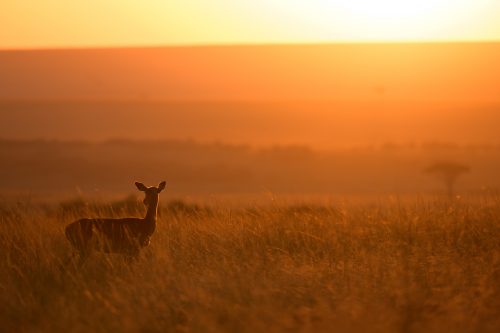Many guests want to capture their safari experience and record memories using photography. Guests arrive with everything from phones to professional cameras and lenses. At Angama, the Photographic Studio helps people with all stages of creating and editing pictures. The team is there to do photoshoots, offer camera rentals, and provide tutorials in both capturing and editing.
For most of the wildlife situations we encounter here in the Mara, a lens with a minimum focal length of 300 or 400-600mm would be ideal. Primes (single-focal-length lenses) are expensive, but some common ranges we see are 100-400, 200-500, and 150-600mm lenses.
The next important factor to consider is shutter speed. When shooting with telephoto lenses, the general rule is to be at least where your focal length is or even double. For example, if I were shooting at 200mm, I would want to be at either 1/200 or faster.
Another option is to shoot with a slow shutter speed to capture motion rather than freeze it. In the image below, the exposure was half a second, and the camera moved in the direction of the zebras in what is called a ‘pan’.
Eyes are the windows to the soul. Eye contact can be really powerful in images, so try to wait for and capture eye contact and unique expressions.
Look for that golden light! Photography is all about light. The best throughout the day is found right after sunrise and before sunset, known as the ‘golden hour’; this is when the light is most diffused and has the warmest temperature.
Remember to tell a story. It is important to consider visual variety in your images so they can come together to tell the full story. We lose the story if all the images look the same and are close-up pictures of animals — always think about context and narrative.
Get down. Low-angle pictures work really well when taking pictures of animals. If you can, get as low as possible. You can even use your articulating screen if you have one. We tend to shoot down at animals from the vehicle, but if your subject can be above your horizon line, it creates a strong, unique image.
Be patient. Things don’t happen on 'your' time when on safari. Sometimes, you have to wait hours for something to happen. Patience pays off.
Think about your composition; be open to trying unique and creative ways to frame your picture. After seeing many wildlife photos, the unique ones stand out.
Be creative and have fun. Look for patterns and textures; look up, down, near, and far. Once you start looking like this, you’ll soon find that there is an endless pool of subject matter. Don’t worry about the weather. There are a thousand beautiful pictures of sunny, clear skies, but often, a bit of rain or clouds can turn a beautiful photograph into stunning.
Filed under: Stories from Angama
Subscribe for Weekly Stories
Comments (0):

Rates & Availability